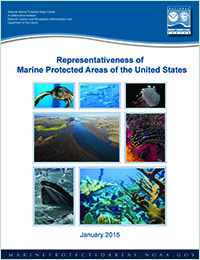-
Home
-
Data & Publications
-
Regional Portals
- About Regional Portals
- Florida
- Navassa Island
- Puerto Rico
- Flower Garden Banks
- U.S. Virgin Islands
- American Samoa
- Commonwealth of the Northern Mariana Islands
- Federated States of Micronesia
- Guam
- Main Hawaiian Islands
- Republic of the Marshall Islands
- Northwestern Hawaiian Islands
- Republic of Palau
- Pacific Remote Island Areas
-
CRCP Activities
- Glossary
Representativeness of Marine Protected Areas of the United States

This analysis of representativeness in 1,628 MPAs is based upon the presence/absence of major habitat types, key natural resources and ecologically important areas and processes. Nationally, MPAs are nominally representative of the major marine ecosystems of the U.S. with (a) 70% of select habitat types (e.g., beaches, corals, seagrass) found within MPAs of the 19 marine ecoregions and in at least one National System MPA in each ecoregion; (b) 82% of select birds, invertebrates and algal ecosystem features found within MPAs of the 19 marine ecoregions and in at least one National System MPA in each ecoregion; (c) 71% of select fish, marine mammal or sea turtle ecosystem features and Endangered Species Act (ESA) listed species found within MPAs of the 19 marine ecoregions and in at least one National System MPA in each ecoregion; and (d) 87% of select ecologically important ecosystem processes found within MPAs of the 19 marine ecoregions and in at least one National System MPA in each ecoregion.
This report also aims to indicate the strength of this representation (e.g., an ecosystem feature found in less than 1% of MPAs in an ecoregion versus more than 75%) by presenting “consumer report” graphics that indicate the relative prevalence of the presence of a resource (though not its spatial extent). The results presented in this report do not alone signify that MPAs are either fully representative or operationally effective. Spatial distribution and abundance of key habitats, species and ecologically important areas within and around MPAs in each ecoregion, particularly in remote and poorly documented areas (e.g., regions and depths), are still generally lacking and are considered an information gap in many areas. While this analysis focuses on the presence of ecosystem features and processes within the national system and the broader set of MPAs within each ecoregion, the level of protection provided to these resources is critical to their effectiveness. Only two ecoregions out of 19 have more than one percent of their area in “no-take” reserves that prohibit all extractive uses – the South Florida/Bahamian Atlantic (4%) and the Hawaiian Archipelago (15%). This first level analysis of resource representativeness of both the National System of MPAs, and of all U.S. MPAs is intended to provide a useful baseline for future analyses of the spatial coverage of habitats and resource groups within MPAs; levels of protection for resources of interest within MPAs; and opportunities to strengthen and expand the nation’s MPAs through enhanced planning and management.
Citation: Brock, R. January 2015. Representativeness of Marine Protected Areas of the United States. U.S. Department of Commerce, National Oceanic and Atmospheric Administration, National Marine Protected Areas Center, Silver Spring, MD. 31 p.
Representativeness of Marine Protected Areas of the United States


